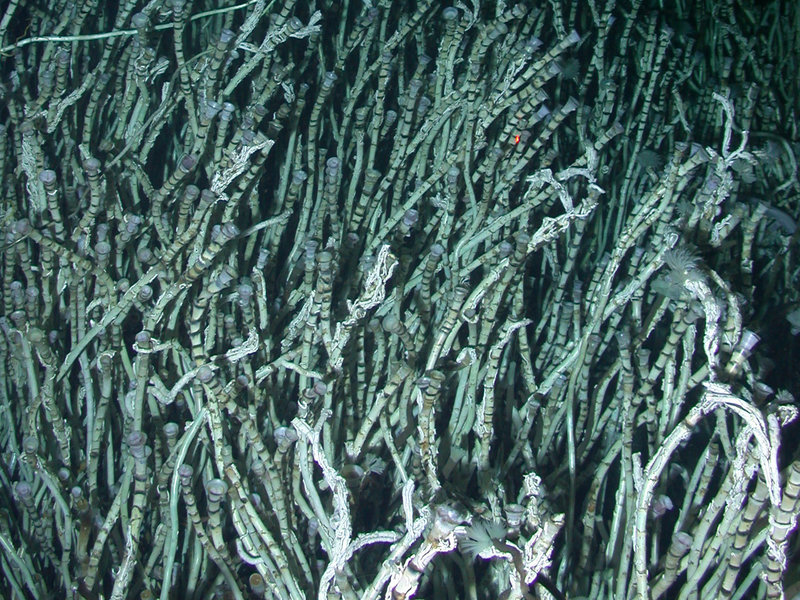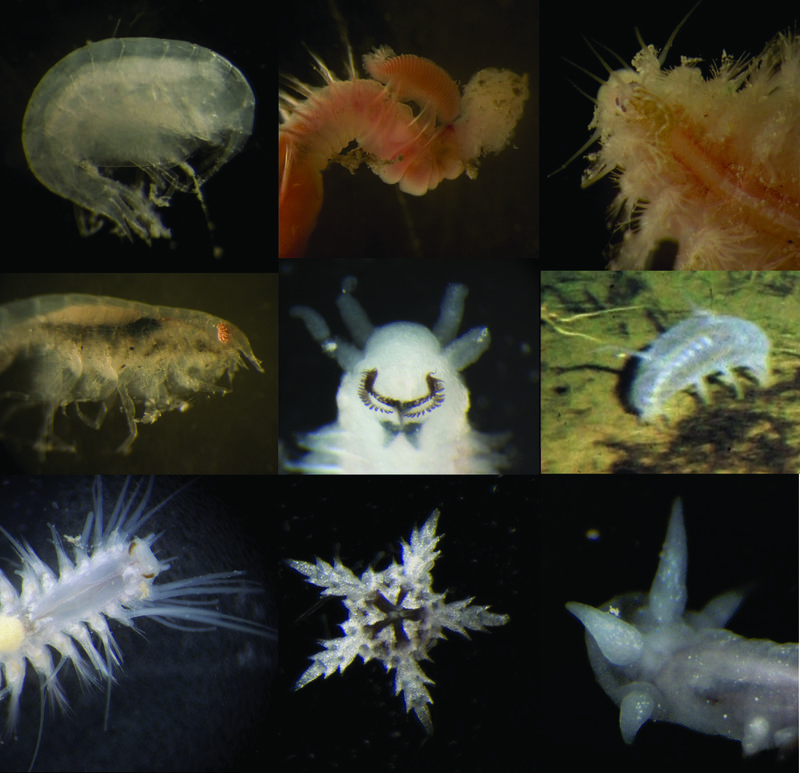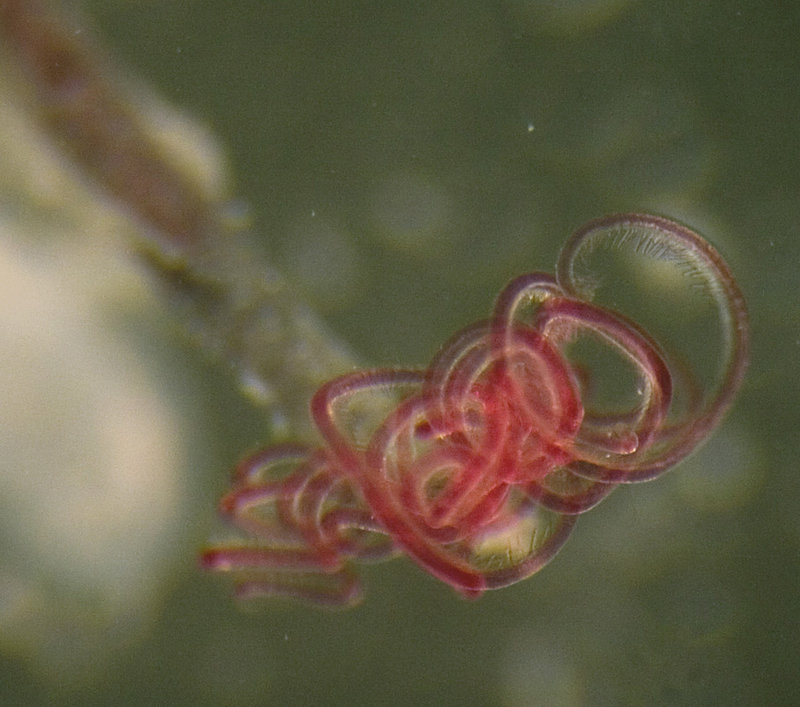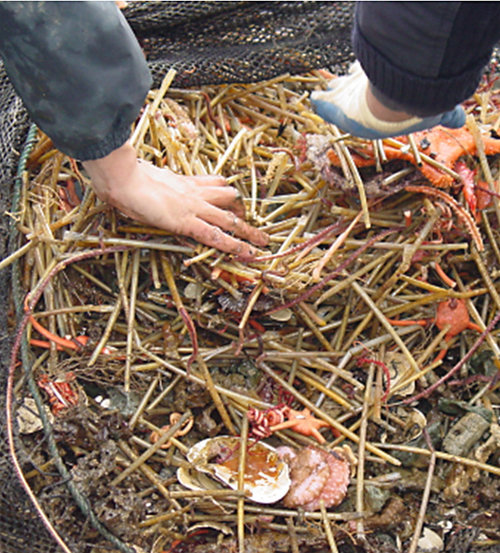
By: Andrew Thurber - Scripps Institution of Oceanography, University of California – San Diego
The deep sea is cold, dark, and inhospitable to humans, but it holds untold and unknown biodiversity (number and variety of organisms found in a region). The word biodiversity conjures up pictures of lush rainforests and coral reefs teeming with life, yet a wealth of species inhabit the deep-sea floor and reducing ecosystems. Worms longer than 2 meters (6 feet) with neither a mouth nor anus live in dense thickets, clams have blue blood, and mussels teem with animals like limpets and snails. All of these exist a depths greater than 1,000 m (3,000 ft) from the surface, far removed from the energy which the sun provides. These reducing ecosystems are fueled by the chemical energy from the earth, and the biodiversity present is not only unique but fragile (figure 1).

Figure 1. Extensive beds of siboglinid polychaetes (beard worms) provide a habitat for many animals. Through evolution, these siboglinids have lost both their mouth and anus; they live on the energy which symbiotic bacteria provide. Image courtesy of CRROCKS/NSF. Download image (jpg, 254 KB).
As the continental margins give way to the vast abyssal plains and extreme trench habitats, the sizes of most animals dwindles, yet diversity is high. The sediment is filled with annelids (segmented worms) that have evolved iridescent cuticles (skin), branchiae (intricate breathing structures), and ferocious jaws. Amphipods, small shrimp-like creatures, usually but not always small, form swarms like roving packs of lions waiting for food to fall from above. And holothurians (sea cucumbers) take unimaginable shapes as they glide across the seafloor like NASA's Mars rovers. These communities reach their maximum diversity at mid-slope depths, between 300 and 1,700 m (900 and 5,100 ft) below the surface. In one square meter (or 3 ft by 3 ft) of the seafloor, one can find 46 species living in or on the mud. This “mud” is truly one of the most species-rich habitats on our globe (figure 2).

Figure 2. Incredible diversity lies in small animals which live in and on the sediment. Amphipods (upper left two photos), ophiuroids (brittle stars; middle bottom), holothurians (sea cucumbers; right middle), and polychaetes (annelid worms; all other photos) are examples of species associated with sediments in this realm of our planet. Image courtesy of CRROCKS/NSF. Download image (jpg, 781 KB).
Reducing ecosystems are named this because the animals found in these systems are fueled by chemical energy from reduced compounds. Once thought to be rare, reducing ecosystems are now known to be ubiquitous, hosting a multitude of undescribed species. During a three-week cruise off New Zealand in 2006, nine methane seeps were discovered. More than 15 vent sites have been discovered in the last 5 years. Through the exploration of these habitats over the past 30 years, 600 new species have been found and many more remain undescribed. Some of these species are so strange they were initially thought to be their own phylum (the highest level of animal classification) before scientists analyzed their DNA to find where they fit in the tree of life (figure 3).

Figure 3. This frenulate, now know to be a type of polychaete in the family Siboglinidae, was collected of New Zealand at 1,140 meters (3,420 feet) and was originally assigned to its own phylum. Through genetic techniques and delicate morphologic study, scientists now know that it is in the same family as those polychaetes in figure 1. Image courtesy of INSPIRE: Chile Margin 2010. Download image (jpg, 111 KB).
Reducing environments further increase deep-sea diversity by providing a unique food source and both biogenic and geologic structural heterogeneity (composed of dissimilar parts). Reduced compounds, including sulfide and methane, are harnessed by Bacteria and Archaea, which take oxygen or sulfate from the overlying water to oxidize these compounds. This forms a source of energy which is used to fix carbon. Many of these bacteria live within or on metazoans (multi-celled animals), as symbionts, providing food to their hosts and allowing their hosts to grow to as large or larger than their shallow-water relatives. Rocks form at hydrothermal vents due to the cooling of lava and at methane seeps as a byproduct (precipitate) of Bacteria and Archaea working together to consume methane.
The generation of hard substrate provides an surface for corals, sponges, and anemones to settle on. Both the large symbiont- bearing animals and those taking advantage of the hard substrate provide a food source for predators, a hiding place for those avoiding predators, and a perch for filter-feeding animals. These filter-feeding animals take advantage of the faster water flow farther off the seafloor to catch more food. At the Concepcion methane seep area, off Chile, the diverse habitats provided by the methane seep has resulted in incredibly high diversity, in part because it attracts animals from surrounding habitats.
Early exploration of recently discovered seeps off Chile suggests the Chile margin represents an entirely novel biogeographic province — an area with almost all species new to science. Three new species of symbiont-bearing clams of the families Solemyidae, Lucinidae, and Thyasiridae have been described; two vesicomyid bivalves and one siboglinid tube worm (Lamellibrachia sp.) are now being described by taxonomists. Four seep-associated gastropods (snails) have been and many mollusks (including a new octopus, limpet, and multiple chiton species) are currently being described. Symbioses never seen in the Southeastern Pacific — two species of polychaete living in the mantle cavity of the seep bivalve Calyptogena gallardoi — have been discovered. Yet much of the margin remains unexplored and many secrets may be uncovered with further exploration (figure 4).

Figure 4. This is an example of the fauna which lives at methane seeps off of Chile. Many of the species are not restricted to seeps but are found in great abundances where the seeps occur. Image courtesy of Javier Sellanes. Download image (jpg, 123 KB).
Much of the deep-sea fauna is slow growing and incredibly susceptible to human activity. Corals can live for more than a hundred years and cold seep tube worms can live for centuries! These same tube worms form bushes that can host more than 40 species, which take advantage of the structure they provide. As fish stocks are depleted in shallow waters and fishing gear technology advances, the depths at which these habitats lie are no longer beyond the realm of fisheries activities. Indeed, fisheries are already common to depths down to 1,000 m (3,000 ft). It takes only a single trawl to destroy a specimen which has taken hundreds of years to grow, removing its structure from the seafloor and thereby removing the habitat of many species. Multiply this by many trawl tows, and it is easy to see why the biological reefs of the deep sea are being decimated. In this renewed age of deep-sea exploration, we are racing to understanding what controls the distribution and diversity of deep-sea life in as pristine a state as possible.
The “normal” deep sea hosts a diversity of species, and this impressive richness is only increased by the heterogeneity provided by reducing habitats. Through discovery, description, and a functional understanding of these habitats, we gain insight into the evolution of life on our planet and how, as humans, we are changing it. We hope to gain this knowledge before these habitats are lost.